Effective Flea Control Strategies for Your Yard
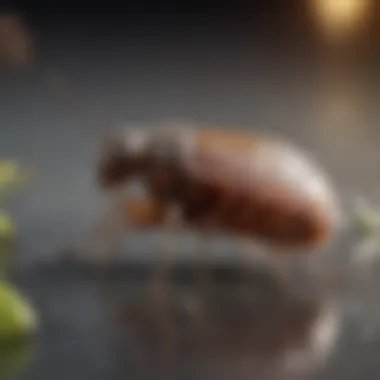
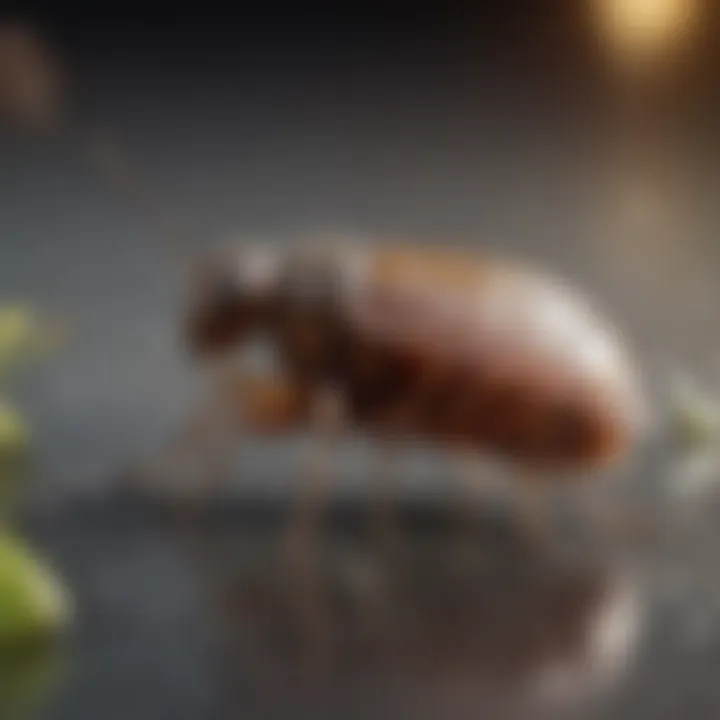
Intro
When it comes to enjoying the great outdoors, few things can put a damper on your day like a flea infestation. These tiny pests aren't just a nuisance; they’re also tricky to get rid of. In this guide, we’ll tackle everything from identifying these critters to prevention and treatment strategies that can help keep your yard a haven rather than a hotspot for fleas. So, let's roll up our sleeves and dive into this essential knowledge that any house owner should possess.
Pest Identification
Understanding what you’re dealing with is the first step in tackling any problem, and fleas are no different. These minuscule, wingless insects, often brown or black in color, can easily be mistaken for other pests if you're not paying close attention.
Detailed Descriptions of Common Pests
The most common types of fleas you'll encounter include the cat flea, the dog flea, and the human flea. The cat flea, scientifically known as Ctenocephalides felis, is the most prevalent and can easily thrive in various environments.
The dog flea (Ctenocephalides canis) is less common but still a frequent visitor in dog parks or yards with dogs roaming around. And while the human flea (Pulex irritans) may not appear as often, it serves as a reminder that these pests don’t discriminate by species.
Signs and Symptoms of Infestations
Recognizing a flea problem is crucial. Look for the following signs:
- Flea Bites: Small, itchy red spots on your skin, particularly around your ankles.
- Flea Dirt: Tiny black specks resembling pepper, which are actually flea feces.
- Pet Behavior: If your pets are scratching, biting, or grooming excessively, it could mean they’ve brought fleas into your yard.
"The best defense against fleas is a good offense; know your enemy!"
Prevention Strategies
Prevention is your strongest ally when it comes to flea control. You want to minimize conditions that attract them and reduce their ability to breed in your yard.
Home Maintenance Tips for Pest Prevention
- Regular Yard Clean-up: Keep your lawn mowed and garden tidy. Fleas thrive in overgrown areas where they can hide and breed.
- Rake and Remove Debris: That includes leaves, clippings, and sticks. These materials can provide shelter for fleas.
- Seal Gaps in Real Estate: Ensure windows, doors, and any cracks are tightly sealed against pests.
Natural Deterrents and Barriers
Consider using some natural deterrents as effective barriers:
- Diatomaceous Earth: Sprinkle food-grade diatomaceous earth in your yard to dehydrate fleas.
- Cedar Chips: Spread cedar chips around your garden, as their scent can repel fleas.
- Essential Oils: Using oils like lavender or peppermint can not only smell great but also deter fleas.
Treatment Options
If prevention fails, it’s time to take action. There are a variety of treatments available for controlling fleas in your yard.
Overview of Chemical vs. Natural Treatments
Chemical treatments often show immediate results, but they can have harmful long-term effects on the environment. On the other hand, natural treatments might take a bit longer but are generally safer for pets and children.
Step-by-Step Guides for DIY Treatments
For those seeking DIY methods,
- Identify the Infestation: Confirm that you indeed have a flea problem.
- Choose Your Treatment: Decide whether you want to use chemicals or natural solutions.
- Apply Treatment: For chemicals, follow the manufacturer's instructions carefully. For natural, sprinkle diatomaceous earth and let it sit for a few days.
- Monitor the Results: Keep an eye on the area and reapply as necessary.
- Regular Maintenance: Continually evaluate your yard and adapt your strategies.
By implementing these practices steadily, you will not only combat existing flea populations but also pave the way for a healthier, flea-free environment in your yard.
Understanding Fleas: An Overview
The journey to keeping your yard flea-free begins with understanding these pesky invaders. Fleas are more than mere nuisances; they can have a significant impact on both your pets and your outdoor space. By grasping the basics of flea life, behaviors, and their potential health threats, homeowners can more effectively implement control measures. Let's unpack the key elements that bring this understanding to the forefront of flea management.
The Life Cycle of Fleas
Fleas go through four distinct stages in their life cycle: egg, larva, pupa, and adult. This cycle can occur relatively quickly, usually within two to three weeks under favorable conditions.
- Egg: Adult fleas lay tiny eggs that might roll off your pet onto carpets, furniture, or the yard.
- Larva: Once hatched, these larvae are blind and feed on flea feces, dust, and other organic material. They thrive in dark, moist areas, making shaded parts of your yard prime real estate for them.
- Pupa: After some time, the larvae spin cocoons. Flea pupae can be quite resilient, remaining dormant for several months until they sense a host nearby.
- Adult: Finally, adult fleas emerge from the cocoon, ready to find a host for blood meals and start the cycle all over.
Understanding this life cycle is crucial because it helps determine the proper timing for control efforts. Ending one phase without addressing others leads to a continued infestation.
Feeding Habits and Behavior
Fleas are primarily bloodsuckers, favoring hosts like cats and dogs. Their feeding habits are not just random; rather, they follow specific patterns that can inform your strategies for control.
- Fleas can leap up to 150 times their own body length, which helps them move quickly between hosts and infested areas.
- Adult fleas typically feed every few hours, which is when they transmit diseases and cause discomfort to pets and people alike.
- Their habits are also affected by environmental factors, such as temperature and humidity. Fleas thrive in warm, moist conditions, underscoring the importance of maintaining a dry yard to keep them at bay.
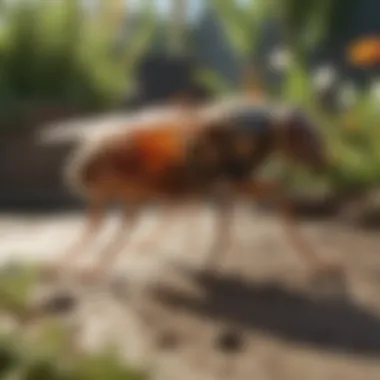
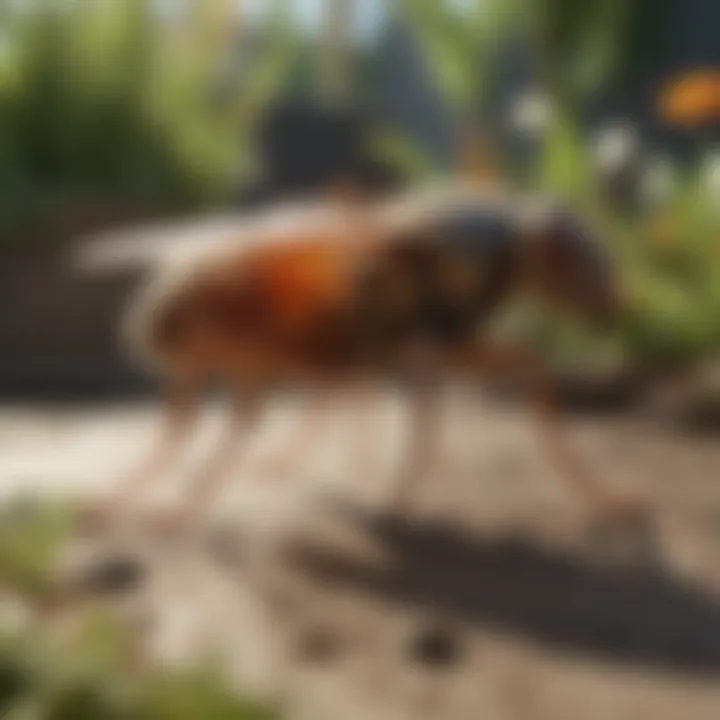
Taking these behaviors into account can help you create an environment less hospitable to these parasites.
Potential Health Risks Associated with Fleas
Fleas are not just an annoyance; they can pose serious health risks to your pets and even to humans. Here are some key concerns:
- Flea Allergy Dermatitis: Many pets develop itchy, painful reactions due to flea bites, which can lead to severe skin infections.
- Tapeworms: These parasites can be transmitted if a pet ingests a flea while grooming. This can cause significant health issues if left untreated.
- Disease Transmission: Fleas are vectors for various diseases, including the bubonic plague and typhus fever, albeit rarely in modern settings. Nonetheless, the potential is there, especially in regions where such diseases are still present.
Understanding these health risks provides an essential motivation for homeowners. Not only is it about keeping your yard clean, but it's also about safeguarding the well-being of your furry family members and yourself.
Identifying Flea Presence in Your Yard
When it comes to keeping your outdoor spaces clean and safe, knowing how to spot fleas is crucial. Fleas not only annoy pets but can also transfer diseases. By identifying flea presence in your yard early on, you'll be more equipped to handle an escalation. This section will highlight specific signs of infestation and pinpoint common habitats for these pesky bugs, giving you insight into how to better manage your yard's ecosystem.
Signs of a Flea Infestation
Recognizing an infestation isn't always straightforward, and some telltale signs may go unnoticed unless you're looking closely.
- Visible Fleas: The most obvious indicator, of course, is seeing the fleas themselves, often jumping quickly from one surface to another. They're small, brownish-black bugs that can leap several times their body length.
- Flea Dirt: This term describes the tiny, black specks that are often confused with dirt. If you notice these on your pets or outdoor surfaces, it indicates flea presence. To confirm, simply wet the specks. If they turn reddish-brown, it’s flea poop, made primarily of digested blood.
- Increased Scratching: If your pets are scratching more frequently or seem excessively uncomfortable while outside, fleas might be the culprit. Keep an eye on their behavior during and after outdoor playtime.
- Unusual Biting and Discomfort: Homeowners might notice bites on themselves or their family members. Fleas can also target humans, leading to itchy spots that often pop up around ankles and lower legs.
Ultimately, brushing your pet's fur, especially in warm weather, can expose flea activity before it spirals out of control.
Common Areas Where Fleas Thrive
Fleas have preferred habitats in yards, and knowing where to look can save you a whole heap of trouble.
- Tall Grass and Weeds: Fleas are drawn to vegetation that offers both shelter and moisture. If your yard hasn’t been mowed regularly, it becomes a prime location for these pests to thrive. Keeping grass trimmed and raking regularly can help reduce their numbers.
- Shady Spots: Underneath trees, decks, or shrubbery, fleas find cool, shaded areas to hide from direct sunlight. These spots can hold moisture, which is vital for fleas to survive and reproduce. Be mindful of how much shade is present in your yard when doing a thorough inspection.
- Pet Rest Areas: Consider where your pets lounge or sleep outdoors. Fleas often set up camp in these comfy spots, so inspecting those areas, such as under doghouses or favorite resting spots, is essential.
- Areas with Other Animals: If you have wildlife visiting your yard, like raccoons or stray cats, fleas can hitch a ride on them, leading to infestations. Regularly check areas around your yard where these animals might frequent.
Knowing where to look is half the battle when it comes to flea infestations. Early recognition of their presence is your best ally in preventing a full-blown invasion.
By keeping an eye out for these signs and hotspots, you can tackle flea control in your yard before it becomes a nuisance. This proactive approach leads to a healthier outdoor space, where your pets can play freely.
Prevention Strategies for Fleas
Effective flea control starts long before the pests make their unwelcome entrance into your yard. By incorporating thoughtful prevention strategies, homeowners can cultivate an environment that deters fleas from taking up residence. Understanding these strategies is essential, as prevention not only saves time and expense in management but also protects the health of both pets and family members.
Maintaining a Healthy Lawn
A well-maintained lawn can do wonders in keeping fleas at bay. Regular mowing not only enhances the aesthetic appeal of your yard but also disrupts fleas’ lifecycles. Aim to cut your grass to a height of around two to three inches, as taller grasses provide a perfect habitat for fleas to thrive. Likewise, ensuring that the lawn is free of debris—such as fallen leaves, branches, and grass clippings—creates an inhospitable environment. Fleas love hiding in these structures, so keep your yard tidy.
Moreover, regular fertilization encourages a lush, dense lawn. A thick lawn makes it tougher for fleas to jump up and establish themselves. Choosing appropriate grass types that are well-suited for your region can also contribute significantly to a healthier ecosystem, thereby minimizing flea habitats.
Reducing Moisture and Shade
Fleas are notorious for thriving in humid conditions, particularly in shaded areas of the yard that trap moisture. To combat this, one strategy is to trim overgrown bushes and trees to allow for adequate sunlight exposure. Sunlight not only dries out damp spots but also nudges fleas to look for more favorable conditions elsewhere.
If you have areas that are prone to water pooling after rain, consider adjusting the landscape slightly. This could involve installing proper drainage systems or altering sloping to encourage water runoff. Keeping the yard dry at all times creates a less appealing environment for fleas and significantly reduces the likelihood of infestation.
Creating a Pest-Resistant Environment
Garden design plays a pivotal role in discouraging flea populations. One approach is to introduce certain plants that naturally repel fleas. For instance, lavender, rosemary, and marigolds are known for their pest-repelling properties and can add beauty to your garden while keeping fleas at bay.
Consider implementing a barrier method as well. Placing gravel or wood chips around the perimeter of your lawn can serve as a deterrent by making it less accessible for fleas to leap over and invade your space. Additionally, incorporating regular pest control measures such as using safe borders of diatomaceous earth can naturally kill fleas on contact, creating an eco-friendly flea management practice.
"Creating an environment that limits flea survival is more effective than waiting for problems to arise and then addressing them."
In summary, by maintaining a healthy lawn, reducing moisture and shade, and creating a pest-resistant environment, homeowners can significantly lower the chances of flea infestations. These strategies will not only enhance the beauty and functionality of your yard but will also provide you peace of mind knowing your outdoor space is less inviting to unwanted pests.
Natural Approaches to Flea Control
When it comes to wrestling with fleas in your yard, natural approaches can be both effective and gentle on the environment. These methods resonate well not only for their pest-repelling properties but also for promoting a healthier outdoor space. Homeowners are increasingly leaning towards natural remedies, finding them less harmful for pets, family, and wildlife. In the age of eco-awareness, wise choices like these have become crucial. Finding a balance between controlling flea populations and maintaining environmental integrity is vital. By utilizing natural strategies, homeowners can actively participate in pest control without resorting to chemical solutions that may pose risks.
Essential Oils and Their Efficacy
Essential oils stand out as a popular choice among natural flea deterrents. They're not just fragrant; they possess strong repellent properties. Oils such as lavender, peppermint, and lemongrass can disrupt the life cycle of fleas and discourage them from taking up residence. To use essential oils effectively, a simple mixture can be prepared. Combining these oils with a carrier, like coconut oil or jojoba oil, can create a potent spray for the yard. Just remember to apply it generously to areas where pets often roam.
How to Use Essential Oils:
- Mix 10-15 drops of your chosen oil with 1 cup of water in a spray bottle.
- Shake well before use.
- Spray in spots prone to flea activity and around pet sleeping areas.
"Essential oils offer a green solution to managing flea problems, combining efficacy with environmental stewardship."
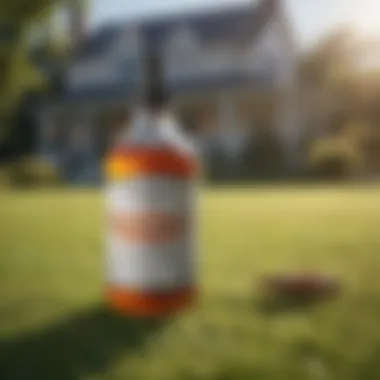

Beneficial Nematodes: A Biological Solution
When one thinks of pest control, the idea of introducing new organisms to the ecosystem might sound counterintuitive. However, beneficial nematodes—microscopic worms—are nature's own pest assailants. These nematodes are predators to flea larvae and can significantly reduce flea populations in the yard.
To introduce these nematodes, you can purchase them from garden centers or online retailers. They come ready for use, and all that needs to be done is to mix them with water and apply them to the soil as per the instructions. The beauty of this method lies in its safety; it does not harm pets or other wildlife. In fact, it boosts the health of your yard by creating a balanced ecosystem.
Herbal Remedies and Their Application
Herbs can also play a role in flea control. Plants such as rosemary, basil, and sage release natural oils that deter fleas. Planting these herbs in your garden not only beautifies the space but promotes an organic barrier against pests.
Moreover, dried herbs can be used effectively. For instance, mixing dried rosemary with salt and scattering it in areas of concern can help combat fleas effectively. Another popular technique is to create herbal sachets to hang in pet areas. These methods are simple yet effective, providing a holistic defense against troublesome fleas.
How to Create an Herbal Sachet:
- Gather dried herbs such as rosemary and sage.
- Fill a small cloth bag with the herbs.
- Hang the sachet in your pet’s sleeping area or any spot you'd like to protect from fleas.
Engaging with these natural methods not only paves the way for a flea-free yard but also fosters an eco-friendly environment. With the right knowledge and tools, homeowners can take proactive steps to safeguard their outdoor spaces.
Chemical Solutions for Flea Control
Chemical solutions for managing fleas in your yard can be quite essential, especially when natural methods do not show results as desired. Many homeowners might think that's a chemical approach has its downsides, but you'll find that knowing how to use them correctly can turn the tide against these pesky insects. Balancing effectiveness with safety is the name of the game here.
Types of Chemical Treatments Available
There’s a range of chemical treatments designed to combat fleas, and understanding these options can help you make informed choices:
- Insect Growth Regulators (IGRs): These work by interrupting the flea life cycle, preventing them from maturing into adults. They do not kill adult fleas but rather keep them from reproducing.
- Adulticides: These are the chemicals that specifically target adult fleas. Popular options include products containing permethrin or imidacloprid. They might be toxic to pets if not properly applied.
- Diatomaceous Earth: A powdery substance, this can be spread around your yard. It kills fleas by dehydrating them. While natural, it's still a chemical solution of sorts, as it alters the environment.
- Beneficial Nematodes: Yes, they're technically living organisms, but they're also treated like chemicals because they are used to control fleas effectively. These microscopic creatures invade the fleas' bodies and help reduce their numbers.
These treatments provide multiple strategies to tackle flea infestations.
Safe Application Techniques
Getting results from chemical treatments demands more than just dousing your yard in sprays. Here are some key safety techniques to keep in mind:
- Read Labels Thoroughly: Always check the manufacturer's guidance on how much to apply and how often. This isn't just about mixing right; it prevents overuse that could harm your pets or plants.
- Timing Matters: Apply treatments during cooler hours of the day, preferably early morning or late afternoon. This minimizes evaporation and ensures both effectiveness and safety for you and your pets.
- Protect Yourself and Pets: Before application, keep pets and children indoors to limit their exposure. Wear gloves and a mask if a product suggests it.
Always allow time for chemical treatments to dry or settle before letting pets back outside. This precaution mitigates any risks associated with direct contact.
- Consider Weather Conditions: Don't apply chemicals right before a rainstorm, as it could wash away your treatment. Wait for dry spells to ensure the chemicals stay put.
Potential Risks of Chemical Treatments
While chemical treatments have their place, it's crucial to acknowledge the potential downsides:
- Chemical Residues: Pesticides can linger in your yard longer than you might think, which can be harmful to other insects and wildlife. This might not be the route for environmentally-conscious homeowners.
- Health Hazards: Some chemicals can be hazardous to your pets. For instance, treatments containing pyrethroids can be toxic to cats, leading to serious health issues.
- Resistance Development: Over time, fleas can build resistance against certain chemicals. This could lead to a vicious cycle of using stronger, potentially harmful products that may not even work in the long term.
Integrating Vaccination and Medication for Pets
Fleas are not just a nuisance for our furry friends; they can lead to serious health implications if not controlled effectively. Integrating vaccination and preventative medications for pets plays a significant role in maintaining a flea-free environment. The importance of this approach cannot be overstated, as it not only protects your pets but also helps manage the overall flea population in your yard.
By ensuring pets are protected through vaccinations, you reduce the risk of infections transmitted by fleas, such as flea allergy dermatitis (FAD) or more severe conditions like tapeworms. Vaccination acts like a safety net. Many pet owners simply think about the external treatments but neglect internal protection. It's essential to create a comprehensive defense against these pests.
Moreover, combining vaccinations with regular medication leads to a higher level of protection. Pets that are consistently treated for fleas won't contribute to the overall flea life cycle as much as untreated pets. This disruption is crucial because it substantially lowers the chance of fleas establishing a foothold in your yard.
Importance of Flea Preventatives for Pets
Implementing flea preventatives is crucial for effective flea control. It's like locking the barn door after the horses have bolted—too late and too little after the infestation starts. Here are some compelling reasons to consider:
- Healthier Pets: Regular flea preventative medications help mitigate risks of flea-borne diseases, keeping your pets happier and heathier.
- Less Stress for Owners: A pet free of fleas is a pet with less scratching and discomfort, meaning a quieter household.
- Reduced Infestation Potential: Healthy pets who are on preventative medications drastically reduce the chances of fleas returning to your yard or home.
Ultimately, flea preventatives can save both time and money. Instead of scrambling to control an existing infestation, maintaining a regular schedule allows you to rest easy, knowing your pets are protected.
Types of Pet Medication Options
Choosing the right flea medication for your pet can seem overwhelming, given the multitude of options available on the market. However, understanding the landscape can make the selection process much simpler. Here are the most common types:
- Topical Treatments: These are applied directly to the skin and are great for rapid action. Brands like Revolution and Frontline are popular because they work quickly and are easily applicable.
- Oral Medications: Pills like Comfortis or NexGard kill fleas within hours and can be more suitable for pets that dislike topical treatments.
- Collars: Flea collars such as those from Seresto provide long-term protection. They release a continuous low dose of insecticide over time.
- Shampoos and Sprays: While these may not be long-term solutions, they can provide immediate relief and help in conjunction with preventative measures.
- Pros: Fast-acting; effective for immediate infestations
- Cons: Can wash off if not applied correctly.


- Pros: Easy to administer; no residue left on the fur
- Cons: Requires strict adherence and can cause side effects in some pets.
- Pros: Long-lasting; low maintenance once put on
- Cons: May not be suitable for all pets (especially small or sensitive ones).
- Pros: Can address visible infestations quickly
- Cons: Work best in combination with other methods.
As you navigate the options, be sure to consult with your veterinarian. They can offer tailored advice based on your pet's specific needs and health history. Implementing a well-rounded strategy that incorporates both vaccination and medication is key for effective flea management.
"Prevention is better than cure," holds especially true in flea control. Regular vaccinations and suitable medications can be the difference between a cozy yard and an infestation fiasco.
Long-Term Management of Fleas
Managing fleas in your yard isn’t a one-off job; it’s more like a marathon than a sprint. Understanding long-term management is key to not just dealing with an infestation but also preventing one from happening again. Fleas have a knack for coming back when least expected, causing stress for pet owners and families alike. Therefore, the focus should be on establishing an enduring battle plan that involves ongoing vigilance, preventive measures, and adjusting strategies as conditions change.
Monitoring and Evaluation Procedures
To keep fleas at bay, it's essential to have a system in place for monitoring and evaluating the situation regularly. Here are some considerations for effective monitoring:
- Regular Inspections: Spend some time each week scouting your yard for signs of fleas. Look in grassy areas, shady spots, and near your pet's favorite lounging spots.
- Use Flea Traps: A simple homemade trap can work wonders to gauge flea activity. Place a shallow dish filled with soapy water under a light source at night. The fleas will jump toward the light and get trapped as they fall into the soapy water. You’ll be able to measure the effectiveness of your control strategies based on the number of fleas collected.
- Pet Monitoring: Keep an eye on your pets for signs of flea presence. Excessive scratching or biting usually signals an infestation. Regularly check their fur and skin as part of your routine.
- Community Knowledge: Engage with neighbors to share findings. Maybe they are dealing with flea problems too. A coordinated community approach can lead to better results over time.
Regular monitoring not only keeps you aware of any arising issues, but it also allows you to adjust your tactics before a small flea problem turns into an outbreak.
Adjusting Strategies Based on Environmental Changes
The environment plays a crucial role in flea control. Whether it’s changing seasons or alterations in your landscaping, adapting your strategies is vital:
- Seasonal Checks: Fleas thrive in hot, humid conditions. So, pay extra attention during spring and summer months. Adjust your flea prevention strategies accordingly, ramping up your efforts as necessary.
- Landscaping Adjustments: If you’ve added new plants or made changes to your yard, consider how these might attract fleas. Keeping grass trimmed and reducing dense foliage can improve sunlight exposure, which disrupts flea life cycles.
- Weather Conditions: If you experience a particularly rainy season, fleas might find new breeding grounds in your yard. Adjust strategies by amping up treatments during and after wet weather.
- Change in Pets: If you bring new animals into your home, ensure that they’re flea-free before allowing them in the yard. New pets can bring in fleas that have been lying low elsewhere.
"An ounce of prevention is worth a pound of cure."
Simple adjustments based on careful observation and environmental conditions can make a world of difference in your flea control efforts.
Common Misconceptions About Fleas
Flea control is often clouded by several myths that can mislead homeowners in their efforts to manage these pests. Understanding these misconceptions is vital for successfully keeping your yard flea-free and ensuring the peace of mind of your family and pets. Many people think of fleas as a simple problem, easily solved with a quick spray or quick-fix solution. However, effective control goes much deeper than that.
One common myth is that fleas are only found in dirty environments. While poor hygiene can certainly exacerbate flea problems, these pests do not discriminate. They can thrive in pristine lawns or in the fenced-off areas of the lushest gardens. What this means is that even the most well-maintained yard can invite fleas if the right conditions are present, such as moisture and nearby hosts.
Often, there is a belief that a single treatment is enough to eradicate fleas entirely. In truth, fleas reproduce at an astonishing rate, and their life cycle includes various stages that are resistant to many treatments. This misconception can lead to frustration when, after a treatment, fleas reappear, giving rise to the false impression that the chosen method was ineffective.
"Fleas can reproduce in a blink of an eye, making understanding their life cycle essential for effective control."
Debunking Myths Surrounding Flea Control
Let’s tackle some of those commonly held beliefs:
- Myth 1: Fleas are only a problem in summer.
Fact: While fleas are more active in warmer weather, they can survive indoors during the cooler months. If your pets bring fleas inside, they can establish a population regardless of the season. - Myth 2: Pets are the only carriers of fleas.
Fact: Fleas can hitch a ride on various animals and even humans. Wildlife and other pets, like feral cats, can transport fleas into your garden. - Myth 3: Spraying for fleas will eliminate them completely.
Fact: Treatment must be comprehensive, addressing larvae, pupae, and adults. Many applications only hit the adult stage, leaving other life stages to re-emerge.
Recognizing these myths can help you tailor a more effective approach to flea control, ensuring that your efforts are both timely and comprehensive.
Understanding Flea Resistance
There’s a growing concern about flea resistance to common treatments, which is often overlooked. When fleas have continuous exposure to the same chemicals, there’s a good chance that some will evolve to withstand it, leading to increased difficulty in managing infestations.
It's important to understand that not all flea treatments are created equal. Some may lose their effectiveness over time, especially with improper use or repeated applications. Many homeowners default to using the same products they’ve always used without considering how their local flea populations might have adapted.
- Rotate Treatments: Just like antibiotics, rotating between different types of treatments can help prevent resistance. Consider combining different methods, from chemical sprays to natural solutions.
- Monitor Effectiveness: Keep a record of the treatments you’ve used and their results. This can guide you in making better choices in the future while also improving prevention strategies.
End: A Comprehensive Approach to Flea Control
In closing, tackling flea control with a thorough and well-rounded strategy is pivotal for anyone looking to keep their yard pest-free. Fleas may seem like a small nuisance, but they come with significant repercussions for pets and humans alike. This article has unfolded a tapestry of knowledge surrounding fleas, from understanding their life cycle to exploring prevention strategies and treatment options.
Adopting best practices like maintaining a healthy lawn and using both natural and chemical solutions smartly can markedly reduce flea populations. The integration of vaccination and medication for pets is equally critical, acting as a frontline defense against these unwelcome guests.
Summarizing Effective Practices
To wrap up our discussion, here are some key takeaways:
- Regular Lawn Care: Keep your grass trimmed and healthy to deter fleas from establishing a home. Fleas prefer to nest in long, damp grass.
- Moisture Management: Avoid stagnant water and check for areas where moisture collects. Fleas thrive in humid environments.
- Natural Predators: Consider releasing beneficial nematodes into your yard. They can help eliminate flea larvae effectively.
- Pet Care: Regularly check and treat pets with vet-recommended flea prevention methods to stop them from bringing fleas into the home.
- Chemical Safety: If you choose to use chemical treatments, ensure you follow application guidelines to minimize risks to your pets and children.
Ultimately, an ongoing assessment of these practices is crucial. Fleas can adapt and multiply quickly, so your strategies need to be flexible. Always keep an eye for signs of resurgence and adjust accordingly.
The Importance of Consistency and Monitoring
Flea control isn’t a one-and-done deal; it requires ongoing attention. A consistent approach to monitoring your yard and addressing signs of flea activity will pay off in the long run.
- Regular Inspections: Make it a habit to inspect your yard and pets frequently. Look for flea droppings or biting behavior in pets.
- Adapting to Changes: Seasonal changes can influence flea behavior, so be prepared to alter your strategies throughout the year.
- Documentation: Keep track of what treatments have been effective and any failures, this will help you streamline your approach over time.
"An ounce of prevention is worth a pound of cure." This old saying rings true with flea control. Consistent monitoring and a solid strategy can help you avoid a full-blown infestation, allowing you to enjoy a yard that's safe and pleasant for your family and pets.



